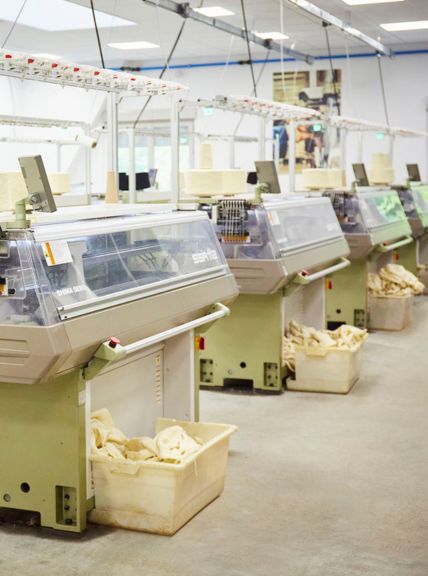Christmas time : Extended returns for 30 days until 12/31/25.

1 – Knitting and remeshing: the first steps in beret making
It all begins with a strand of carded wool, sourced from the finest merino sheep fleece, carefully untangled and prepared. This yarn, naturally ecru-colored and renowned for its exceptional qualities, is then knitted to create the famous beret "galette."
Knitting is a delicate process that involves precisely managing the number of stitches, with increases and decreases, to achieve the distinctive round shape of the Basque beret. At Maison Laulhère, this operation is carried out using knitting machines developed in-house, specially designed to faithfully reproduce traditional techniques.
Once the knitting is complete, the remeshing step follows, which involves closing the knitwork by catching the stitches from both edges to achieve a perfectly circular shape. This technique ensures the strength and flawless finish that have built the reputation of Maison Laulhère berets.


2 - Felting and dyeing: the heart of our craftsmanship
Felting is an essential step in the making of the beret at Maison Laulhère. The knitwork is subjected to mechanical action in warm soapy water — a process called "fulling" — which allows the wool fibers to naturally interlock. Thanks to the unique properties of merino wool, whose fibers are covered with microscopic scales, the beret gains density while reducing in diameter, eventually taking on the appearance of a thick, supple, waterproof, and breathable fabric.
The expertise of the felting specialist lies in the precise control of this process, carefully adjusting the different parameters to strike the perfect balance between suppleness and strength.
Dyeing then follows — another key step that contributes to the visual identity of Maison Laulhère berets. The deep and vibrant shades, a signature of the Maison, are achieved through pigment blends meticulously prepared by our dyers, based on unique recipes developed over the years.
The final result is the product of true expertise, relying on the careful control of many variables: the quality of the yarn, the purity of the water, the temperature, and the duration of the dye bath.
True to its commitment to environmentally responsible production, Maison Laulhère uses natural pigments, sourced notably from beetroot, avocado, madder root, and onion, ensuring durable colors that respect the planet.



3 – Blocking and finishing: shaping the beret
After the dyeing process, the beret moves on to the blocking stage, where it is placed on a wooden mold that will give it its final diameter after drying. This shaping process is essential to ensure the perfect fit and aesthetic of the beret.
The headband is then carefully blocked, brushed, and sheared to achieve the signature velvety finish that defines the elegance of Maison Laulhère designs. At each step, a thorough visual inspection is carried out to ensure the high-quality standards of the Maison. Only berets that meet these strict criteria proceed to the final stages of production.
Crafting a beret requires two full days of work, sometimes more, involving a series of precise checks, adjustments, and expert gestures. Each piece is thus the result of a unique craftsmanship, passed down and perfected through generations, giving life to an authentic, durable beret, proudly made in France.
The making of a beret requires two whole days of work, sometimes more, and a multitude of checks and adjustments that make each item unique.


4 – Assembly: the finishing touches that define the beret’s identity
The final step in the manufacturing process is assembly, where each beret receives the elements that give it its identity and unique character.
The lining, usually made of satin, is added inside the beret to provide both comfort and elegance. The leather headband, carefully sewn in place, determines the head circumference. The beret is then adorned with its "bouffette," a colored ribbon bow that is emblematic of tradition.
Finally comes the embroidered badge, stitched onto the lining, which marks the authenticity of Maison Laulhère, along with the enamelled rivet and all the other embellishments that give each model those unique details you love so much.
Every finishing touch is applied with the utmost care, in keeping with the craftsmanship excellence that defines the true French beret.


5 – FINAL CARE: the last gestures of excellence
Before being ready to meet its future owner, each beret undergoes the final care stage — an ultimate gesture that reflects all the attention to detail and high standards of Maison Laulhère.
Although inspected at every stage of its production, the beret receives here one last expert check: a meticulous inspection to detect the slightest imperfection, such as a tiny particle caught in the wool fibers, carefully removed with tweezers. To perfect the piece, a final pass with a natural fiber brush enhances the material, ensuring a flawless finish — soft to the eye and to the touch.
This final gesture embodies the spirit of Maison Laulhère: a true passion for well-crafted work and a deep respect for authentic French craftsmanship.




